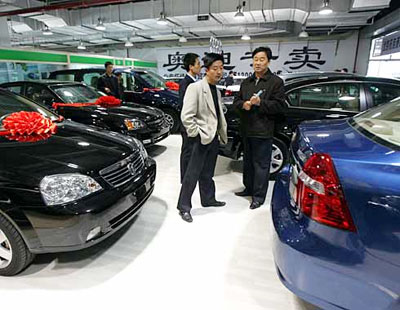http://www.usatoday.com/money/world/2006-10-25-china-profits-usat_x.htm?csp=34
HONG
KONG -- The elusive China Dream is fast becoming reality for many US
companies.
US corporate profits in China passed $2 billion the first six
months of 2006, up more than 50% from the first half of last year, according to
the US Bureau of Economic Analysis. US companies are on pace to earn more in
China this year than they earned there during the entire 1990s, notes Joseph
Quinlan, chief market strategist at Bank of America.

Potential customers look at Buick and Chevrolet cars at a
sales office in Beijing on October 18, 2006.
[AP] |
The government numbers are consistent with
private surveys: 81% of companies belonging to the US-China Business Council, a
lobbying group, reported that their China operations were profitable. More than
half said profitability in China matched or beat their worldwide profit margins,
according to a recent council survey.
In 1999, the US State Department found that just 57% of US firms were
profitable in China.
Equipment manufacturer Caterpillar cited strong growth in China, among other
things, last week when it reported a 21% increase in third-quarter earnings.
Like most US companies, Caterpillar doesn't report China revenue and earnings
separately and won't talk about them in any detail.
But a telling sign of China's importance to the company: Over the past 2.5
years, Caterpillar has doubled its China workforce to 5,000, says Jim Dugan, the
company's spokesman in Beijing.
"Just about any place you go in China, there are road and railroad and
construction and energy projects," Dugan says. "Those are all fields where we
play ball."
'Business is good'
Starbucks, which already operates more than 190 stores in 19 Chinese cities,
doesn't break out its financial performance in China. But spokesman Eden Woon
says, "Business is good. We are accelerating our growth."
Not all successful US companies in China are household names: Greif, a
Delaware, Ohio-based maker of industrial packaging, says profits are strong and
growing in China, a market it entered five years ago when it acquired a
competitor already operating there.
For centuries, Western businesses have cast covetous eyes at China, a dream
market with the world's biggest population, now 1.3 billion. And it's virtually
untouched by modern marketing. But their visions of profits, dating back to
Marco Polo and before, usually came to nothing. They've been dashed by war,
political turmoil, corruption, bureaucracy and grinding rural poverty.
"Time and again," journalist Joe Studwell wrote in his 2002 book, The China
Dream, "China has failed to fulfill the promise that foreigners ascribe to her."
But now, China's economy, which began opening to foreign investment and trade
in the late 1970s, is booming, expanding at about 10% a year.
Living standards have improved in urban centers such as Beijing, Shanghai and
Shenzhen, creating a middle class -- and opportunities for US firms from
Starbucks to General Motors.
From 1999 to 2004, according to statistics compiled by the American Chambers
of Commerce in Beijing and Shanghai, the number of broadband lines rose to 31.7
million from 2.2 million.
Automobile ownership rose to 22 per thousand Chinese from one per thousand.
Cellphones surged to 111 per thousand Chinese from three per thousand.
Learning how to do business
China's entry into the World Trade Organization in 2001 made it easier for
foreign companies to operate there. The WTO deal required China in 2004 to start
letting foreign firms distribute their goods without first entering into
alliances with state-owned Chinese partners, which often siphoned profits and
stole technology. These days, more US companies are going it alone profitably
without Chinese partners. The percentage of American Chamber members operating
as joint ventures in China slid from 78% in 1999 to 27% in 2005.
US companies have learned how to do business in China. "Companies have gained
experience from the early years," says Robert Poole, vice president of China
operations at the US-China Business Council. "They trained people, established
management systems, built reputations for their products."
US firms still face problems in China. Good help is hard to find. Theft of
intellectual property is rampant. Competition is fierce as young Chinese
companies try to take on more-established Western firms. Greif, for instance,
reckons it has 400 competitors in China. But for now the profits are rolling in,
and US companies are confident about the future: 97% told the US-China Business
Council that they were optimistic about their prospects in China over the next
five years.
"When the economy is growing this fast, profits will increase," says
Studwell, founder of the China Economic Quarterly. "At the same time, foreign
firms have learned hugely from their mistakes of the 1990s."
Courtesy of USA TODAY